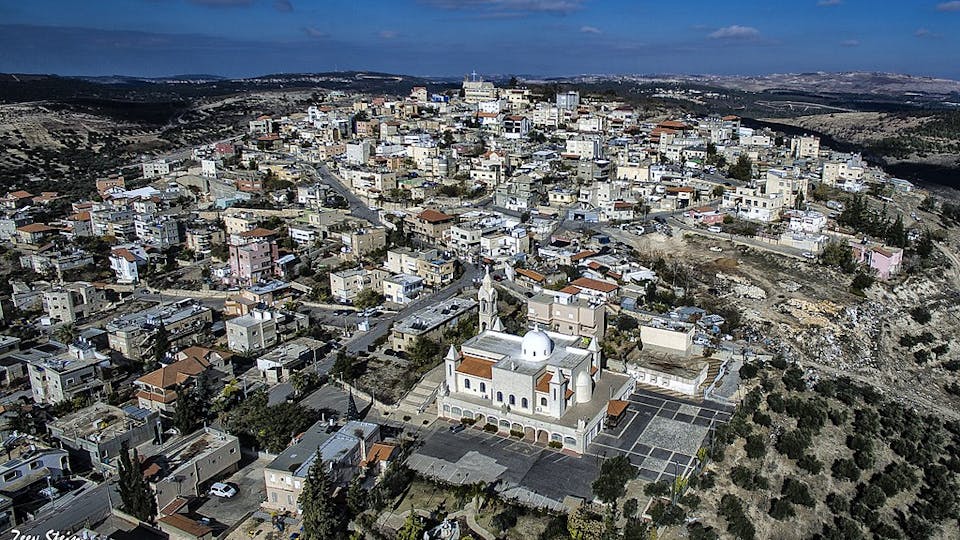Discovering the Aramaean Biblical Roots: A Journey Through Time

"My Father Was a Wandering Aramaean..." (Deuteronomy 26:5)
The Aramaean Christian community, with its deep historical roots, has gained recognition from the Israeli Parliament and the wider faith community. These modern disciples of Jesus bring to life the ancient history of Israel and the early Messianic community of the First Century AD. The Aramaean roots, culture, and language date back over 3,000 years; spreading across the Middle East through conquests and migrations. Aramaic was a common language among Jews in Israel and Galilee during the Second Temple period, through to the time of Jesus.
Revival of Aramaean Heritage
Leading the revival of the Aramaean heritage is IDF (reserve) Major Shadi Khalloul, Founder and President of the Israeli Christian Aramaic Association (ICAA). Born into the Aramaean Christian community of northern Galilee and Syria, Major Khalloul dedicates his life to restoring and recognizing the profound Aramaean roots and language— the very language spoken by Jesus and his disciples.
The ICAA's mission is to promote the Aramaean identity and legacy. Major Khalloul’s efforts have led to the Aramaean community’s recognition as a distinct national minority in Israel. This historic recognition separates the Aramaeans from the Arab national identity with which they were long associated.
The Aramaean Community in Israel

The Aramaean community in Israel, numbering around 10,000, proudly identifies with their ancient Aramaean biblical roots and the early Messianic movement. Their spoken language is the Aramaic dialect used by Jesus. Over centuries, as empires rose and fell, the Aramaean community was absorbed into the Byzantine Christian Empire, later becoming recognized as Christian Arabs after the Muslim conquests.
Today, the original Messianic/Christian Aramaean identity is celebrated in Israel. Sar-El Tours offers visitors the chance to connect with this vibrant community, experience their culture, and hear personal stories.
The Jewish/Aramaean Pre-Military Academy
Major Khalloul also founded the Christian Aramaic-Jewish Pre-Military Educational Program, "Mechinat Kinneret," the only program of its kind in Israel. It brings together Christian Aramaeans and Jewish youth in a seven-month program, fostering cultural bridges and preparing participants for military service and life in Israeli society. This program promotes intercultural understanding, integrating Christian Aramaic youth into Israeli society through rigorous training and education.
Visitors can experience this unique initiative through Sar-El Tours, meeting the young participants and learning about their experiences and the program’s vision.
Ancient Aramaean Roots in Biblical History

The Aramaean roots go deep into biblical history. Genesis 10 lists Aram among the children of Shem, and Deuteronomy 26:5 mentions a "wandering Aramaean" ancestor. The Aramaean people and language played a vital role in the cultural history of the Middle East long before the Arab Islamic conquests.
Aramaean communities historically spanned four religions—Christianity, Islam, Judaism, and Mandaeism—and their language, Syriac, remains significant in various Christian churches. Despite political changes, Aramaic continued to influence religious and cultural developments, including the early Christian faith.
Aramaeans in Biblical and Ancient Texts
Aram appears in both the Bible and ancient texts as a place and a personal name. Assyrian records from Tiglath-Pileser I (1114-1076 BC) mention an Aramaean people group. The region east of the Euphrates is referred to as Aram-Naharaim in the Bible, encompassing modern Israel, northwestern Jordan, Lebanon, western and northwestern Syria, and Iraq.
The Aramaean kingdoms, peaking around 1000 BC, eventually fell to the Assyrian Empire. However, the Aramaean language persisted, becoming central to administration in the Babylonian and Persian Empires. By the time of Jesus, Aramaic was the dominant language in the Middle East.
The Aramaean Connection to Israel
The Aramaeans had extensive connections with ancient Israel. Biblical traditions suggest a shared origin and numerous mixed marriages. The Aramaean kingdoms in Syria often interacted with the Northern Kingdom of Israel, evident in cultural and political exchanges.
The Aramaeans and Early Christianity
The Aramaean Christian roots trace back to the early Messianic community in Israel. Various Christian denominations—Maronite, Syriac Orthodox, Syrian Catholic, Church of the East, Chaldean, Greek Orthodox, and Greek Catholic—share the Aramaic language; preserving their religious and linguistic uniqueness despite historical upheavals.
Aramaean Identity and Modern Challenges
The migration of Aramaean-speaking churches to the West has led to identity challenges. In Israel, nearly 170,000 Christians, mostly registered as Arabs, can now identify as Aramaean, thanks to efforts by Major Khalloul and historical research. While only a small number have changed their registration, the movement is growing.
A Language Preserved Through Millennia
Aramaic, spoken for over 3,000 years, was the language of Jesus and His disciples. Despite historical challenges, the Aramaic language and heritage continue to thrive, particularly within the Israeli Christian Aramaean community.
Experience the Aramaean Legacy
Visit the Aramaean community during your next trip to Israel with Sar-El Tours. Discover the rich heritage, hear the Aramaic language, and connect with a history that spans millennia.
Frequently Asked Questions (FAQs)
1. What are the Aramaean Biblical roots?
The Aramaean Biblical roots refer to the ancient heritage, culture, and language of the Aramaean people, which date back over 3,000 years. These roots are intertwined with the early history of Israel and the development of the Messianic/Christian community during the First Century AD.
2. Who are the modern Aramaeans?
Modern Aramaeans are descendants of the ancient Aramaean people who have preserved their unique cultural and linguistic heritage. In Israel, they are recognized as a distinct national minority and continue to speak the Aramaic dialect, the language of Jesus and His disciples.
3. How is the Aramaic language significant in biblical history?
Aramaic was a common language among Jews in Israel and Galilee during the Second Temple period. It was the language spoken by Jesus and His disciples, making it an essential part of the early Christian faith and biblical history.
4. What efforts are being made to preserve the Aramaean heritage in Israel?
Efforts to preserve the Aramaean heritage in Israel include the work of the Israeli Christian Aramaic Association (ICAA) and Major Shadi Khalloul. These initiatives focus on promoting the Aramaean identity, language, and cultural legacy, as well as political recognition of the Aramaean community.
For more information, visit the Israeli Christian Aramaic Association here and follow the Pre-Military Program on Instagram here.
Conclusion
The Aramaean heritage is a hidden gem in the fields of history. By visiting Israel and engaging with the Aramaean community, you can uncover this ancient legacy and experience the language and culture of the people who were integral to the early Christian faith. Contact Sar-El Tours to book your visit and explore the Aramaean roots that continue to inspire today.
